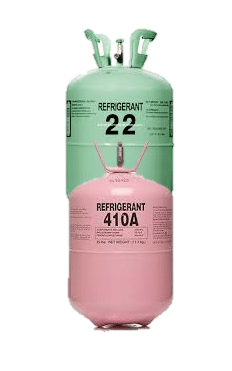
Refrigerants of the Past, Present, and Future
Every air conditioner or heat pump uses a type of chemical known as a refrigerant. The job of a refrigerant is to absorb heat from the air and transport that heat through coils and pipes to be released somewhere else. For air conditioning, the refrigerant absorbs heat from the air inside your home, and then releases that heat outside. For heating, the refrigerant absorbs heat from the outside air and transfers that heat into your home.
While all air conditioners and heat pumps use refrigerant of some kind, they don’t actually all use the same type. Because of environmental concerns and improvements in energy efficiency, the refrigerants most commonly used have changed over time. They will continue to change in the future. Let’s take a look at three of the most important types of refrigerant used in residential HVAC systems. There is one from the past, one from the present, and one that will likely be commonly used in the future.
See Also: R22 Phase out Information
The Past: R22
For several decades, the refrigerant most commonly used in residential HVAC systems was a hydro-chlorofluorocarbon (HCFC) called R-22. It’s commonly referred to by the brand name Freon. While R-22 worked well, it turned out that it had one serious drawback. Because of the chlorine in them, R-22 and other CFCs had a destructive effect on the ozone layer in the earth’s atmosphere.
National Geographic explains it in their article “The Facts of Ozone Depletion.” CFCs are the chemicals most responsible for damaging the earth’s ozone layer over the past several decades. The ozone layer is a layer high up in the earth’s atmosphere that protects us from harmful ultraviolet B radiation from the sun. Increasing ultraviolet B radiation hurt animals and plants and causes skin cancer and cataracts in humans.
In order to protect the ozone layer that protects us all, nations around the world began banning the use of CFCs. This includes R-22. Since 2010, new air conditioners and heat pumps installed in the United States cannot use R-22. As of 2020, R-22 refrigerant will be banned completely. That means if you have an HVAC unit that uses R-22, you’ll no longer be able to have it recharged if it gets a leak. So if you have an older unit that uses R-22, you should plan on replacing it by 2020.
See Also: Things to Consider When Replacing Existing Heating and Air Conditioning Unit
The Present: R410a
The refrigerant that was designed to replace R-22 is called R-410a, which is sold under the brand name Puron.
- R-410a does not contain chlorine and it has zero negative effect on the ozone layer.
- Since nations around the world have started taking steps to limit the release of CFCs, including phasing out R-22, damage to the ozone layer has been slowly reversing.
- R-410a is better at absorbing and releasing heat than R-22, which makes it more energy efficient.
- That means lower monthly energy bills for homeowners.
As the phase-out of R-22 continues, R-410a becomes more and more common in residential HVAC units. Almost all new air conditioners and heat pumps sold today use it. Unfortunately, older HVAC units that were designed for R-22 cannot simply be emptied and recharged with R-410a because R-410a has to be kept at a higher pressure than R-22.
While R-410a is significantly better for the ozone layer than R-22, it does still create some environmental concerns.
- R-410a is actually a mixture of two other refrigerants, it can’t be easily recycled, and widespread refrigerant recycling is expected to become more common in the future.
- R-410a is a powerful greenhouse gas. In other words, if it gets released into the atmosphere—for instance, from a leaking air conditioner–it can contribute significantly to climate change.
See Also: Why is 410a So Expensive
The Future: R-32
Because of concerns about recycling and climate change, the refrigerant of the future will most likely be R-32. As mentioned above, R-410a is a mixture of two different refrigerants, and one of those components is R-32.
- Like R-410a, R-32 has no negative effect on the ozone layer.
- R-32 alone has the added benefit of being a much weaker greenhouse gas.
- When R-32 is released into the atmosphere, it won’t affect the climate nearly as much as R-410a (or R-22).
- According to Daikin Industries, a leading manufacturer of refrigerants, if all R-410a currently in use was converted to R-32, it would decrease the amount of global warming caused by refrigerants in 2030 by almost 20%. That’s equivalent to cutting carbon dioxide emissions by 800 million tons!
- Over a 100-year period, switching to R-32 would decrease global warming caused by refrigerants by 30%.
- Because R-32 is a single refrigerant, not a mix, it will be easier to recycle in the future.
- R-32 is more energy efficient than R-410a, which means it could both reduce climate change even more and reduce those monthly energy bills.
Why didn’t we just switch to R-32 instead of R-410a? The downside of R-32 is that it’s mildly flammable and therefore difficult to handle. That’s why it’s been getting mixed with R-125 to make it non-flammable. This creates R-410a.
Daikin Industries manufactures both refrigerants and air conditioners. It has succeeded in designing and launching the first residential split-system air conditioning units that use R-32. While these R-32 air conditioners are currently only available in Asia, in the future we expect to see them becoming available in the United States as well.


